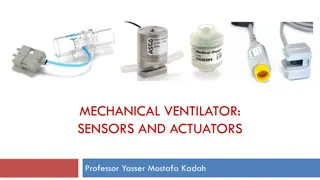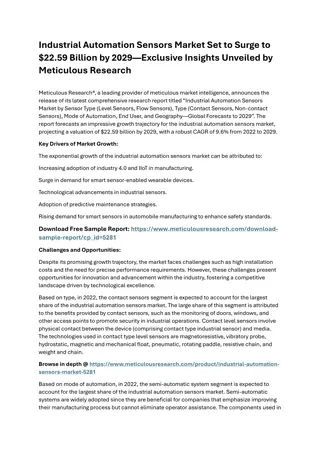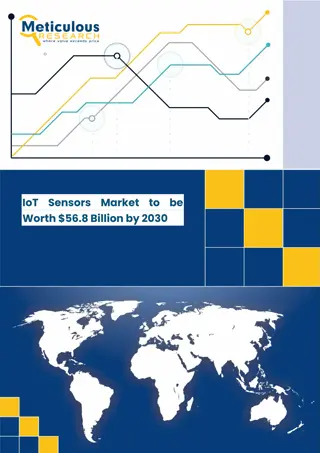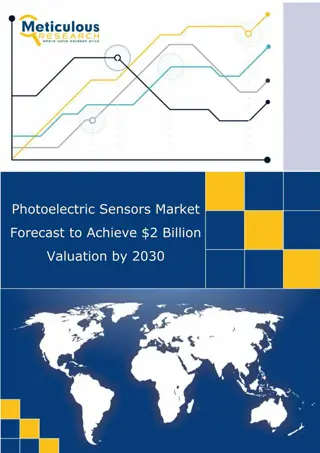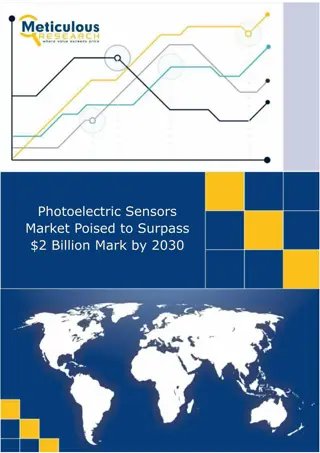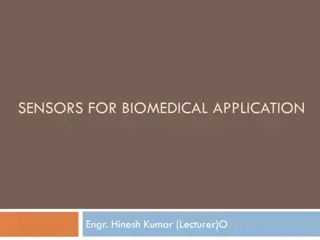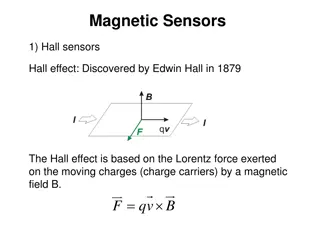Understanding Semiconductor Sensors and their Applications
Semiconductor sensors are versatile devices that utilize semiconductor materials like silicon for detecting and measuring various non-electrical quantities. These sensors leverage the unique properties of silicon, such as high tensile strength, Young Modulus, and resistance to corrosion, making them ideal for developing smart sensor systems. Planar silicon technology allows for precise integration of passive and active components on a silicon wafer, enabling the production of efficient transducer chips. Modern semiconductor sensors come in various forms, including pressure sensors with piezoresistive elements and silicon diaphragms, offering a wide range of applications in pressure and acceleration measurements.
Download Presentation

Please find below an Image/Link to download the presentation.
The content on the website is provided AS IS for your information and personal use only. It may not be sold, licensed, or shared on other websites without obtaining consent from the author. Download presentation by click this link. If you encounter any issues during the download, it is possible that the publisher has removed the file from their server.
E N D
Presentation Transcript
SENSORS ER.SOMESH KR MALHOTRA,ASSISTANT PROFESSOR,ECE DEPARTMENT,UIET
INTRODUCTION All living species are endowed with the sensory organ and actuating device for carrying out their routine activities. Sensing precedes actuation and the signal obtained after sensing , may undergoes some processes . The first one after sensing, is the measurement process, when a man in intrested in making use of the sense signal for all activites conceived by him. To gain knowledge and organize several activites, a large number of sensing system are needed and they are known as TRANSDUCERS TRANSDUCERS and lately as SENSORS SENSORS. A sensing system of the present day is termed and identified as SENSOR the system. SENSOR no matter how many component make
SEMICONDUCTOR SENSORS A semiconductor material is known to behave as an insulator at certain temperatures and as a conductor at other temperatures. Other substances and compounds that display similar characteristics are also classified as semiconductors .the ceramic and ferroelectric material are some of them. Likewise several new materials have been identified thereby enlarging the scope of application to detection and measurement of several non-electrical quantites. Silicon is the most favoured and largely utilized element with all its physical properties extremely suited for development of smart sensor.
SEMICONDUCTOR SENSORS Silicon possesses certain unique properties both mechanical and electrical, resulting in its popularity for embedded IC on the transducer chip High tensile strength High Young Modulus High strength-to-weight ratio High fragie strength Negligible hystresis High corrosive resistance It has exceptional property of accepting high surface finish
SEMICONDUCTOR SENSORS Planar silicon technology is rendered possible by applying photo-lithographic method and an oxide window masking On one side of a silicon wafer, it is possible to incorporate passive and active component and their interconnections. It is very easy to deposit a metal layer on to a silicon wafer and suitable etching techniques. Laser techniques and advanced manufacturing technology enable the production of accurate resistor on a silicon chip. These resistors are of permalloy(nickle-iron alloy) with high temperature coefficient of resistance and hence suitable for temperature measurement . The chip can be 1 mm sq and of thickness 10 m.
SEMICONDUCTOR SENSORS Modern pressure sensor are now available in two forms One with piezo-resistive element integrated with the silicon diaphragm and the other silicon diaphragm itself forming as one plate of a capacitor system Both are available as smart sensor for a wide range of pressure Likewise strain bar of silicon for pressure and cantilever beam of silicon for acceleration measurement are available as integrated resistive pressure sensor using the piezo-resistive elements The piezo-resistive effect noticed in Si and Ge when doped has been successfully applied for measurement of mechanical strain. Semiconductor yields large value of Hall coefficients.A large number of Hall effect sensor are brought out as a micro-sensor for measurement of a large number of variables including electrical quantites. The anisotropic stress effect in PN junctions,wherein mobility of charge carrier is detected and measured when a small force is applied by means of diamond stylus (with sharp tip).
SEMICONDUCTOR SENSORS A typical PN junction diode is also used as a position sensor by making use of lateral photo effect.When a light spot illuminates a silicon solar cell. An emf is developed across the ohmic contact as a function of the position of the light spot. Using this effect , two dimensional light spot sensitive photo-diode are fabricated.
SMART SENSOR Smart sensors Smart sensors can be defined as those sensors in which much of the signal conditioning is carried within the transducer housing and which will provide standardized output signals in digital form, and suited for transmission via a communication bus to the central control room. They will linearized their own output compensate for environmental changes, and include self calibration and diagnostic functions, both for themselves and for the system to which they are applied. A Soft sensor Soft sensor is a sensor that handles mathematical operations necessary to deliver the output signal in the desired dimensions, after affecting computation on the measured data obtained from other sensors. Smart field Device Smart field Device is defined as microprocessor based process transmitter or actuator that support two way communication with a host, digitized the transuducer signals and digitally connects its process variable values to improve system performance.
CONFIGURATION OF SMART SENSOR A typical smart sensor is configured with the three following elements: A physical transducer A network interface, and A processor and memory core The signal from the transducer is fed to ADC so as to be acceptable to the microprocessor as shown in figure.The processor will perform some processing on the digital data depending on how it is programmed. The network receives the data from the processor and the network interface block handles the transaction between the processor and the network field bus. It is possible that all the above are implemented on a single chip, thereby attributing the qualification of smartness to the sensing system.
MICRO SENSOR A microsystem is an assembly of many small elements coupled together in a way to effect a desired function and the microsensor is one of them . Mechatronics is known as to consitiute successful integration of mechanical and electronics devices and the microsystem belong to the same family , which nowadays are known as MEMs(Micro electro Mechanical system), The micro sensor in most cases, a combination of sensing system and electronic circuits, integrated to silicon substrate . The successful production of microsensor is possible because of the production process in nanotechnology dealing with micron-size objects.
MICRO SIZE MICROPHONE Peizoelectric biomorph can be created at micro level and can be used as acoustic pressure sensor or microphone. Or it can be used as an inverse transducer as microspeakers. Usually, a single piezoelectric wafer is used on a silicon nitride diaphragm. For use with the biomorph, parylene-D is preferred for reasons of high thermal stability and flexibility. A couple of transverse expander mode piezoelectric films are used to serve as a biomorph and they are connected so as to develop ouput signals of voltage between the two outer electrodes, when the diaphragm is strained due to applied pressure. ZnO serve as substrate material, sputter deposited at 250 degree C on the diaphragm. The entire micromachined system is shown to be better in sensitivity as well as the signal to noise ratio, when compared to the conventional system . It is extensively used in hearing aids and other diagnostic systems in medical profession.
HALL EFFECT SENSOR The structure of the hall effect sensor is shown in fig.in which the contacts for admission of current and pickup of output voltage are all on the silicon wafers or film deposited on the n-doped silicon substrate. The sensor is sensitive to magnetic field oriented horizontally in the plane of wafer. To enhance the sensitivity to magnetic fields, concentrator of magnetic field are located directly on the chip
POLYMER SENSOR A large number of polymer sensor are being developed using polymer thick film paste consisting polymer matrix of Epoxy silicon Phenolic resin on wide variety of substrate. That combined with filler particles of different physical properties Copper and silver particles are for conductive pastes Carbon particles for resistive pastes Solvents are added for use of ink for screen printing Lead sirconate titanium particle added to paste to make piezoelectric sensors Carbon filled sensors with its piezoresistive properties can be used as strain gauge.
Present day concern about healthcare of patient as well as the condition monitoring of machine and system in industry, has resulted in development of several infra-red instrumentation systems such as thermometer, thermographs and other pollution monitoring equipments. IR RADIATION SENSOR IR radiation sources are classiified as Thermal: Thermal: every hot body having temperature above 0K emits IR radiation purely by virtue of its temperature and are known as thermal phenomena which developed IR thermometery. thermal sources. sources.This is the Non Non- -thermal: I thermal: In some sources when some quantum mechanical activities are done may be simple tungsten filament lamp,light emitting diode or Laser, then this type is known as Non Non- -thermal sources thermal sources.
IR RADIATION SENSOR The distinction is equally to be noticed in the principles of operation of the detectors for IR radiation. IR thermal detectors, sense temperature change brought about in them by absorption of heat energy by some sensing element , known already as Thermocouple Thermopiles Bolometer etc The sensitivity of the detector is the ratio of the signal obtained to the incident power , usually expressed in volts/watt or amps/watt. The characteristics of the radiation source should be specified and the detector area is specified for each so that radition flux can be calculated. For certain application, the sensitivity at each wavelength is specified as monochromatic sensitivity. For quantum or photoelectric sensors, the sensitivity is necessarily specified as luminous sensitivity in amp/lumen.
IR RADIATION SENSOR There are other following characteristics which are determined for photon detector Response curve Response time Time constant Impedance.
Infrared thermometers are specialyy meant for measurement of temperature below 650 degree C right down to -100 degree C making use of thermal detectors for detection of emitted IR energy. A slightly different thermal detector , preferred for use in IR gas analyzer, is the Golay thermal detector, based on pneumatics.(explained in next slide) THERMAL DETECTORS The pyrometeric detectors is essentially a capacitor that can be charged by an influx of heat. It consist of a crystalline substance capable of generating electric charge in response to heat flow. The substance is kept between a pair of electrodes and a heat absorbing layer is provided on one electrode and the IR radiation is incident on this layer
THERMAL DETECTORS The Golay thermal detector is a type of opto-acoustic detector mainly used for infrared spectroscopy. It consists of a gas-filled enclosure with an infrared absorbing material and a flexible diaphragm or membrane. When infrared radiation is absorbed, it heats the gas, causing it to expand. The resulting increase in pressure deforms the membrane. Light reflected off the membrane is detected by a photodiode, and motion of the membrane produces a change in the signal on the photodiode. The Golay cell has high sensitivity and a flat response over a very broad range of frequencies. The response time is modest, of order 10 ms. The detector performance is degraded in the presence of mechanical vibrations.
Quantum detectors or photon detectors on other hand , are wavelength dependent and are not limited to thermal effects.. In photoelectric effect where one quantum of radiation release a quantity of electric charge. They are normally non-uniform in their spectral response, which increase with and then falls to negligible levels at a known as a cutoff wavelength 0(or threshold wavelength). QUANTUM DETECTORS Each detector has its own peak wavelength at which it exhibits maximum response and its own 0. The photoelectric effect is mainly characterized by the energy of the incident quantum, which shows up thermal energy, only when it is greater than the energy needed for excitation.
IR thermometer consists of thermal detectors sensitive to the wavelength of radiation from 0.72 to 20 micron. The radiation is brought to focus by mean of lenses, the lense materials being transparent to the spectrum of frequencies of the above region. IR THERMOMETERY No single material is available for the entire region and so choice is limited to those that cover the maximum range of s in each application. The detector need to be small in size and of low thermal capacity. Among all the thermal detectors , the thermocouple and the thermopile are widely used.



